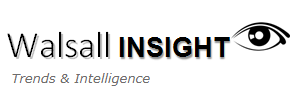Walsall Insight
Walsall Insight provides a data-driven overview of the Walsall borough through a range of statistics, infographics & reports. There are critical pieces of work such as the Joint Strategic Needs Assessment , a series of ward/locality profiles & a repository of key Publications. Please check our News page for the latest updates & feel free to explore our key topics which give insight into the Walsall borough.
Walsall is a metropolitan borough consisting of a mix of urban, suburban and semi-rural communities. Covering 40 square miles, it is located to the north-west of Birmingham, and is one of the four local authorities that make up the Black Country sub-region (with Dudley, Sandwell and Wolverhampton). Walsall town centre lies at the heart of the borough surrounded by Aldridge, Bloxwich, Brownhills, Darlaston and Willenhall district centres.
Walsall’s overall population of 285,500 (ONS 2019) residents is predicted to increase by 5.9% over 10 years, from 274,200 in 2014 to 290,200 in 2024. Like many areas, the predicted growth of Walsall’s older population (> 65) is higher than this at 12.4%. There has already been an 8.8% increase in births in Walsall between 2004 and 2014, and the number of reception pupils in Walsall schools has increased 11.34% between 2012 and 2017. Therefore, planning to meet the needs of a growing younger population as well as a growing number of older people is incorporated within the Local Authorities’ key strategic priorities, while recognising that the proportion of residents likely to be economically active is projected to fall.
Walsall is a culturally diverse town where people of Indian, Pakistani and Bangladeshi background form the largest minority ethnic groups. The number of non-UK born residents in Walsall increased by 3.7% (or 9,900 people) between the 2001 and 2011 censuses and Walsall now has a small Eastern European population who make up about 1% of residents (2,700 people in total). In terms of children and young people aged 0-17, the proportion of pupils from minority ethnic groups has increased to 37.4% of all pupils living in the area from 36.7% in 2016 and 24% Primary pupils have English as an additional language. (School Census, January 2017). As at 31st March 2017, there are eight Unaccompanied Asylum Seeking Children for whom the Local Authority are Corporate Parents, which is lower than other West Midland authorities.
Ward Profiles
Insight into the demography and characteristics of Walsall's wards.
JSNA
Walsall's Joint Strategic Needs Assessment.
Publications
A variety of publications such as Needs Assessments, Strategies and Director of Public Health reports.
Population
Statistics and figures about the population of Walsall.
Deprivation
The latest picture of deprivation across Walsall and its relative position within England.
Diversity
Data about the diversity and ethnicity in Walsall.
Greenhouse Gases
Insight around Greenhouse Gas Emission estimates within Walsall.
Posters
Posters highlighting innovative projects, presented at national conferences.







